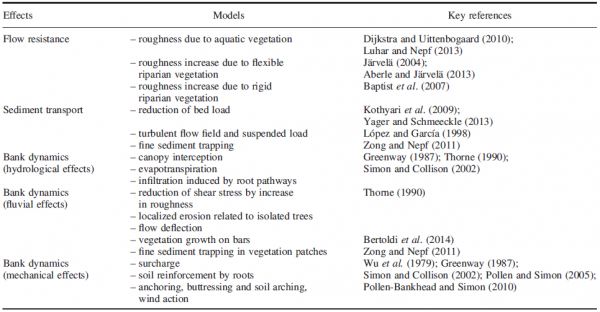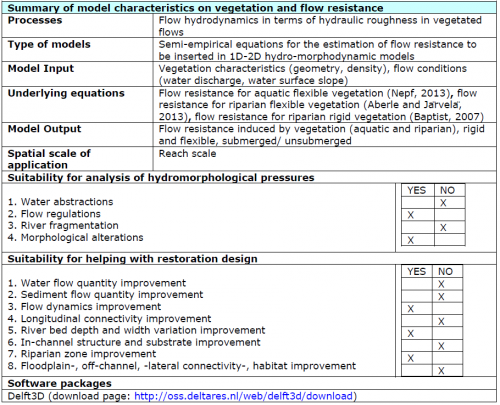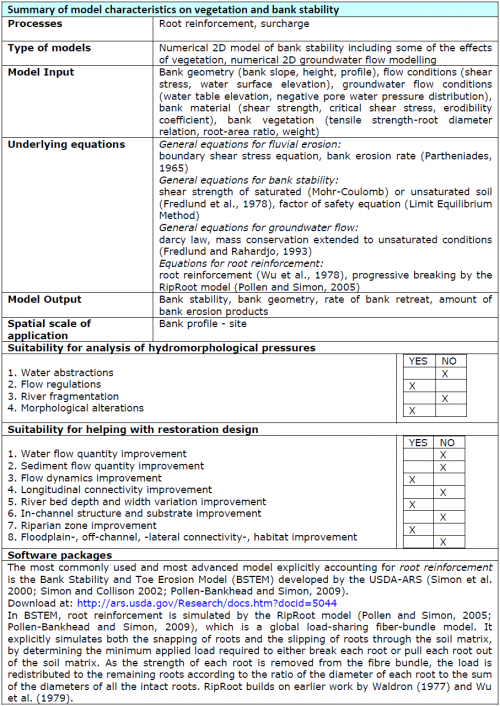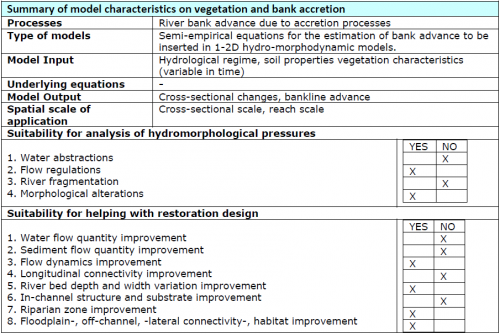Difference between revisions of "Effect of vegetation on hydromorphodynamics"
m |
m |
||
| (7 intermediate revisions by the same user not shown) | |||
| Line 2: | Line 2: | ||
Vegetation can influence river hydrodynamics by changing the turbulent flow field and the averaged velocity profiles in comparison with those that can be commonly found in | Vegetation can influence river hydrodynamics by changing the turbulent flow field and the averaged velocity profiles in comparison with those that can be commonly found in | ||
| − | non-vegetated flows. In this way, vegetation potentially has a relevant effect on flow resistance, sediment transport and bank dynamics. | + | non-vegetated flows. In this way, vegetation potentially has a relevant effect on flow resistance, sediment transport and bank dynamics (see Table 1). |
| + | |||
| + | [[File:VegHymoInteractions_Hydromorphodynamics.png|center|thumb|600px| Table 1. Models for the effects of vegetation on hydromorphodynamics.]] | ||
| + | |||
| + | |||
| + | ===Vegetation and flow resistance=== | ||
| + | Tables 2 summarises the suitability of models with flow resistance for the analysis of hydromorphological pressures or the design of restoration measures. | ||
| + | |||
| + | [[File:VegHymoInteractions_FlowRes.png|center|thumb|500px| Table 2. Summary of model characteristics on vegetation and flow resistance.]] | ||
| + | |||
| + | Future research is needed on the following topics: | ||
| + | |||
| + | - Effect of different types and growth stages of vegetation (rigid or flexible) and different vegetation densities on flow turbulence structure and secondary currents of a stream; | ||
| + | |||
| + | - Effect of plant reconfiguration with increasing flow velocity on drag; | ||
| + | |||
| + | - Effect of the spatial distribution of vegetation at a reach scale on flow resistance; | ||
| + | |||
| + | - Uprooting, breakage of plants during high-flow conditions may give rise to significant changes in flow resistance between the rising and falling limbs of the hydrograph; | ||
| + | |||
| + | - Develop suitable parameterization to characterize different species. | ||
| + | |||
| + | |||
| + | ===Vegetation and sediment transport=== | ||
| + | Research on the effect of vegetation on sediment transport is needed in relation to the following topics: | ||
| + | - Characterization of turbulent coherent structures in mobile vegetated channels in order to understand flow conditions leading to deposition and substrate stability of a given particle size; | ||
| + | - The impact of spatial variability of vegetation on flow and sediment transport; | ||
| + | - Formulation of models for evaluating sediment transport incorporating the effect of turbulence and vegetation properties. | ||
| + | |||
| + | |||
| + | ===Vegetation and bank dynamics=== | ||
| + | Tables 3 and 4 summarise the suitability of models with bank stability and accretion, respectively, for the analysis of hydromorphological pressures or the design of restoration measures. | ||
| + | |||
| + | [[File:VegHymoInteractions_BankStab.png|center|thumb|500px| Table 3. Summary of model characteristics on vegetation and bank stability.]] | ||
| + | |||
| + | [[File:VegHymoInteractions_BankAcc.png|center|thumb|500px| Table 4. Summary of model characteristics on vegetation and bank accretion.]] | ||
| + | |||
| + | Future research and modelling challenges: | ||
| + | |||
| + | - More work is needed to better understand the hydrological effects of riparian vegetation and to incorporate them into models of bank erosion and failures. | ||
| + | |||
| + | - Another area of knowledge gaps concerns modelling interactions of the various erosion processes and mass failures, and the relative role of vegetation on near-bank hydrodynamic flow conditions, erodibility parameters, and shear strength. In order to extend results from a bank profile to a reach and account for variability of hydrodynamic, geotechnical, and vegetational conditions, vegetation should be included into 3-D morphodynamic models. | ||
| + | |||
| + | - Concerning bank accretion modelling is still in its infancy. Recommendations relate to three main aspects: the inclusion of vegetation dynamics, the influence of the high variability of flows, and the up-scaling of the effects acting at different scales. | ||
Latest revision as of 19:25, 30 June 2015
Vegetation can influence river hydrodynamics by changing the turbulent flow field and the averaged velocity profiles in comparison with those that can be commonly found in
non-vegetated flows. In this way, vegetation potentially has a relevant effect on flow resistance, sediment transport and bank dynamics (see Table 1).
Vegetation and flow resistance
Tables 2 summarises the suitability of models with flow resistance for the analysis of hydromorphological pressures or the design of restoration measures.
Future research is needed on the following topics:
- Effect of different types and growth stages of vegetation (rigid or flexible) and different vegetation densities on flow turbulence structure and secondary currents of a stream;
- Effect of plant reconfiguration with increasing flow velocity on drag;
- Effect of the spatial distribution of vegetation at a reach scale on flow resistance;
- Uprooting, breakage of plants during high-flow conditions may give rise to significant changes in flow resistance between the rising and falling limbs of the hydrograph;
- Develop suitable parameterization to characterize different species.
Vegetation and sediment transport
Research on the effect of vegetation on sediment transport is needed in relation to the following topics: - Characterization of turbulent coherent structures in mobile vegetated channels in order to understand flow conditions leading to deposition and substrate stability of a given particle size; - The impact of spatial variability of vegetation on flow and sediment transport; - Formulation of models for evaluating sediment transport incorporating the effect of turbulence and vegetation properties.
Vegetation and bank dynamics
Tables 3 and 4 summarise the suitability of models with bank stability and accretion, respectively, for the analysis of hydromorphological pressures or the design of restoration measures.
Future research and modelling challenges:
- More work is needed to better understand the hydrological effects of riparian vegetation and to incorporate them into models of bank erosion and failures.
- Another area of knowledge gaps concerns modelling interactions of the various erosion processes and mass failures, and the relative role of vegetation on near-bank hydrodynamic flow conditions, erodibility parameters, and shear strength. In order to extend results from a bank profile to a reach and account for variability of hydrodynamic, geotechnical, and vegetational conditions, vegetation should be included into 3-D morphodynamic models.
- Concerning bank accretion modelling is still in its infancy. Recommendations relate to three main aspects: the inclusion of vegetation dynamics, the influence of the high variability of flows, and the up-scaling of the effects acting at different scales.



